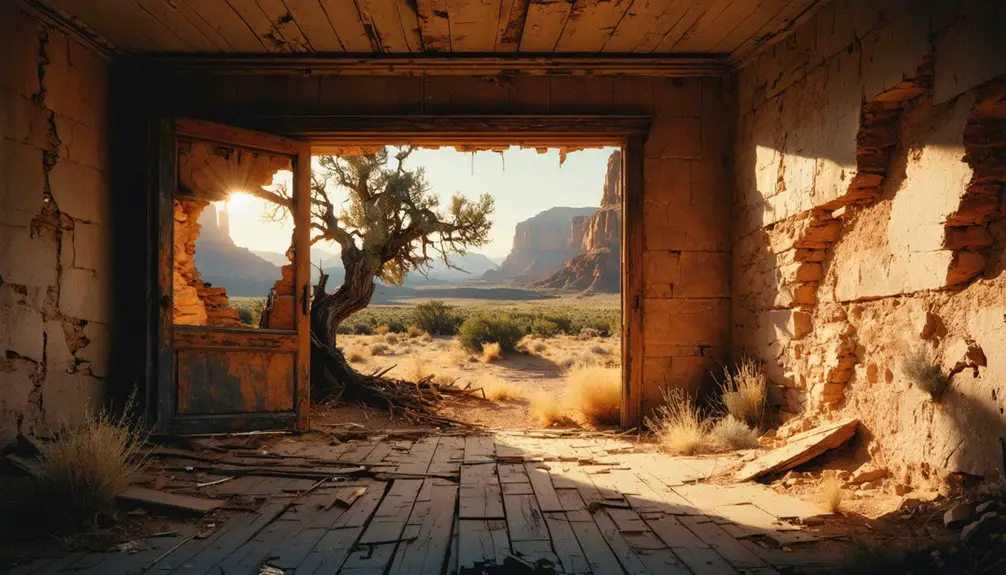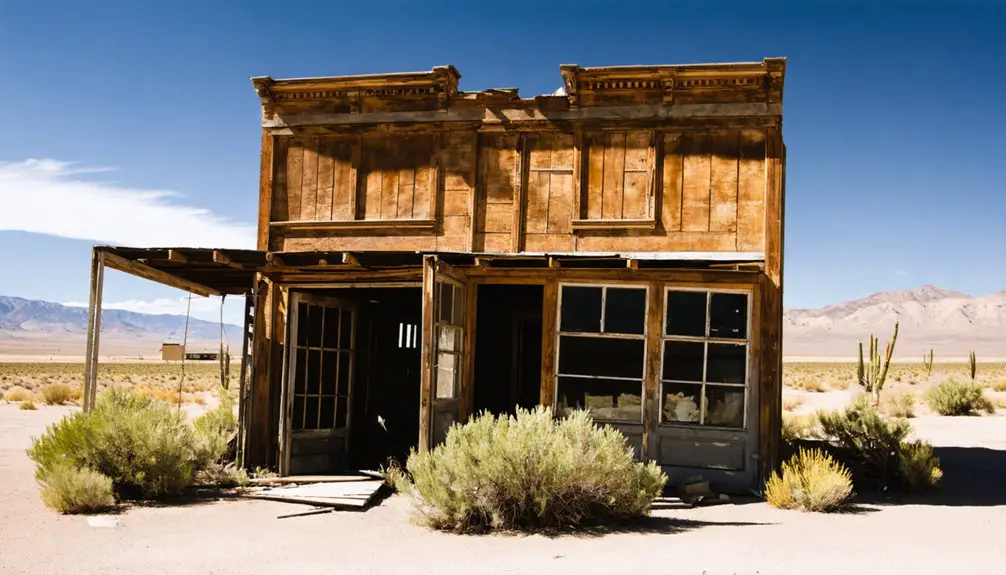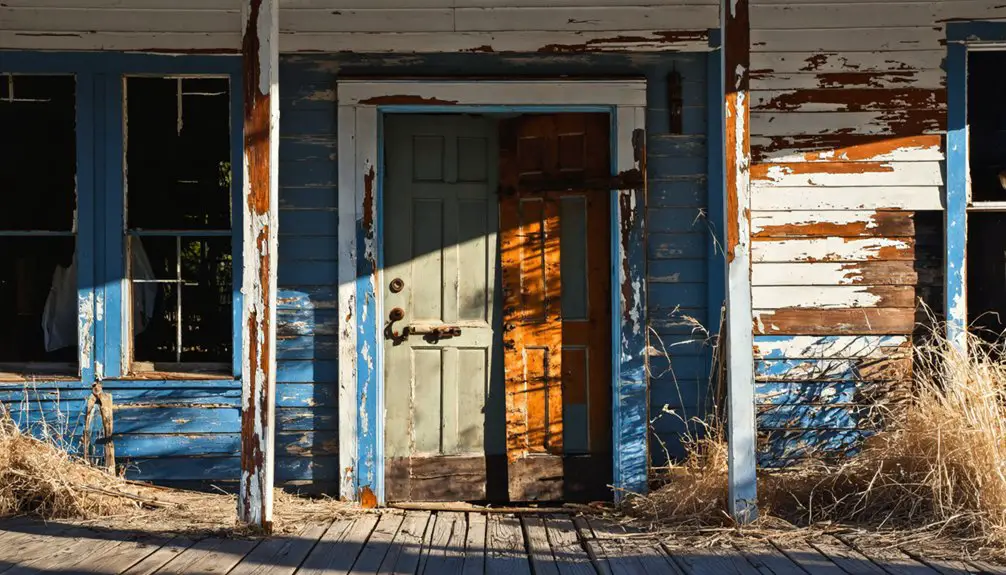You’ll find Loseeville two miles east of Utah Route 12, where Mormon pioneers Ebenezer Bryce and Daniel Goulding established their settlement in the late 1870s. The community flourished briefly through innovative irrigation systems and communal farming before facing environmental challenges that led to its abandonment. Later, the ghost town gained new life as a Hollywood Western film location, hosting stars like John Wayne and Ronald Reagan. The site’s dual history as both authentic pioneer settlement and movie backdrop holds fascinating tales within its weathered remnants.
Key Takeaways
- Loseeville was established in the 1870s by Mormon pioneers Ebenezer Bryce and Daniel Goulding, becoming an official community in Pine Creek Valley by 1886.
- The ghost town contains remnants of pioneer life including a small cemetery with seven identified graves and building foundations.
- Environmental challenges, including mudslides and mining hazards from over 450 mine openings, contributed to the town’s eventual abandonment.
- The site became a popular filming location for Western movies, featuring stars like John Wayne and earning the region the nickname “Little Hollywood.”
- Located 2 miles east of Utah Route 12 near Tropic, Loseeville is accessible via dirt road during spring through fall.
The Rise and Fall of Early Settlement
When Ebenezer Bryce and Daniel Goulding first settled the area in the late 1870s, they established what would briefly flourish as the Mormon pioneer community of Loseeville.
You’ll find their earliest settlement challenges revolved around water access, which they addressed by constructing an irrigation ditch from Pine Creek to sustain farming in the valley. The community was officially established in Pine Creek Valley in 1886. Like other pioneer settlements of the era, they faced devastating setbacks when heavy flooding threatened their community’s survival.
Struggles Against Nature’s Forces
While early settlers like Bryce and Goulding managed to establish initial irrigation systems, Loseeville’s inhabitants soon faced devastating environmental challenges that would ultimately seal the town’s fate.
You’ll find evidence of their struggles in the toxic tailings and discolored hills that remain, stark reminders of the mining hazards that plagued the community. The area contained over 450 mine openings scattered throughout the surrounding landscape.
Natural disasters, including massive mudslides and flash floods, reshaped the canyon’s landscape, while geological instability from active fault lines threatened both mines and buildings.
The town’s position over fractured rock formations led to frequent collapses, and water scarcity made sustainable living nearly impossible. The situation mirrored modern challenges like the historic low levels of Utah’s Great Salt Lake.
Environmental degradation from mining operations left a lasting legacy of contaminated soil and dangerous mine shafts, making any attempts to resettle the area too risky to pursue.
Mormon Pioneer Legacy
You’ll find that Loseeville exemplifies the typical Mormon pioneer settlement pattern, where church leaders carefully selected and organized the site according to Joseph Smith’s City of Zion concept.
The faithful farmers who settled here persevered through harsh conditions, establishing communal agricultural practices and sharing limited resources like water and timber. Early settlers relied heavily on their cooperative faith to overcome difficulties together. The pioneers showed remarkable resilience facing flooding and drought challenges similar to those encountered at other settlements.
Their dedication to building a theocratic community reflected the broader Mormon colonization strategy of the late 1800s, which aimed to create self-sufficient settlements throughout Utah Territory.
Settlement By Church Leaders
Under the direction of LDS Church President John Taylor, the settlement of southeastern Utah gained momentum in 1880 with the launch of the Hole in the Rock expedition.
Church leadership carefully orchestrated settlement patterns, selecting pioneers with vital skills and establishing communities based on the City of Zion concept. The early settlements followed Joseph Smith’s vision of creating self-sufficient agrarian communities with designated city lots.
The settlement strategy proved successful, as demonstrated by the establishment of over 500 Mormon villages across the western territories.
You’ll find these key elements in the church-directed colonization:
- Strategic selection of sites with access to water and farmable land
- Organized community planning with grid layouts and central gathering places
- Development of essential infrastructure including irrigation systems and cooperative stores
As you explore Utah’s pioneer settlements, you’ll notice how the church’s influence shaped not just the physical layout of communities, but also their social structure.
Leaders coordinated specific missions like the Iron Mission and Cotton Mission to guarantee the region’s economic independence.
Faithful Farmers Persevere
The Mormon pioneers’ settlement success hinged on their remarkable ability to transform Utah’s arid landscape into productive farmland. With only 16 inches of annual rainfall, you’d have thought farming impossible, yet their faith resilience drove them to innovate.
They quickly established irrigation systems, diverting water from City Creek just days after arrival in 1847. Their agrarian values, deeply rooted in religious teachings, inspired them to dig over 1,000 miles of canals by 1865. The pioneers developed communal irrigation systems that prioritized community needs over individual profit. By 1890, their innovative farming methods had enabled them to irrigate 265,000 acres of Utah land.
You can trace their influence through the impressive crop yields they achieved – up to 90 bushels per acre for wheat, oats, and barley. This agricultural mastery helped them establish self-sufficient communities and proved their critics wrong.
Tales From the Abandoned Town
While many ghost towns inspire dramatic tales of conflict or tragedy, Loseeville’s stories center on the quiet struggles of pioneer families against an unforgiving landscape.
You’ll find that community resilience emerged through shared hardships as settlers battled persistent water scarcity in their quest to establish a sustainable home.
The town’s most telling stories revolve around three key elements:
- The dogged determination of early settlers Bryce and Goulding, who built the first irrigation ditch only to abandon their dreams within five years.
- The formation of the Clifton Irrigation Company in 1891, representing the community’s united effort to manage scarce water resources.
- The gradual exodus of families who, despite their best efforts, couldn’t overcome the harsh realities of insufficient water supply.
Historic Sites and Remnants Today

Standing one mile east of the Pahreah River and four miles north of Cannonville, Loseeville’s remnants offer visitors a poignant glimpse into Utah’s pioneer past.
Nestled in Utah’s rugged terrain, Loseeville’s ghostly remains whisper stories of pioneer determination and frontier dreams.
You’ll find a small cemetery containing seven identified graves dating back to 1889, including the final resting places of founders Isaac Huff Losee and Sarah Gilbert Losee. Their cemetery’s significance extends beyond mere burial grounds – it’s a memorial to the town’s earliest settlers.
While most original structures have succumbed to time, you can still explore building foundations and trace the paths of pioneer irrigation remnants.
The original Pine Creek ditch system, managed by the Clifton Irrigation Company in 1891, has largely vanished, though modern farms now utilize water from East Fork and Henderson Canyon sources.
Hollywood’s Ghost Town Connection
While you won’t find the sprawling film sets that made Kanab famous, Loseeville’s rugged terrain and authentic frontier structures caught Hollywood’s attention during Utah’s Western movie boom.
You’ll spot several distinctive rock formations and weathered buildings that appeared in background shots of 1950s Western productions, though specific film titles have been lost to time.
The site’s enduring appeal to location scouts stems from its untouched desert setting and genuine pioneer-era architecture, which provided ready-made backdrops for Western films without requiring elaborate set construction.
Film History Landmarks
As Hollywood’s film industry expanded westward in the early 1920s, Loseeville emerged as one of several purpose-built ghost town sets that transformed Southern Utah into a cinematic frontier.
You’ll find these landmark locations dotting the landscape near Kanab, where film iconography and cinematic storytelling brought the Old West to life.
These historic filming grounds earned their place in Hollywood history through:
- Authentic period construction featuring weather-beaten facades, dusty main streets, and detailed Western architecture
- Decades of productions featuring legendary stars like John Wayne, Ronald Reagan, and Frank Sinatra
- Lasting cultural impact that earned the region its “Little Hollywood” nickname
Today, you can explore these preserved movie sets, which stand as a tribute to Utah’s golden age of Western filmmaking, offering a tangible connection to Hollywood’s pioneering spirit.
Western Movies Location Legacy
The cinematic legacy of Western ghost towns extends far beyond Loseeville’s borders, with dozens of abandoned settlements and purpose-built sets dotting the American Southwest’s landscape.
You’ll find Hollywood’s influence throughout Utah’s terrain, where places like Pioneertown transformed from bustling film sets into tourist destinations after hosting over 50 productions.
The region’s cinematic heritage lives on through iconic locations that served as backdrops for classics like *Winchester ’73* and *Monte Walsh*.
While many sets have succumbed to abandonment as Western films declined in popularity, others have found new life as cultural landmarks.
These atmospheric towns, with their authentic period architecture and genuine desolation, continue to captivate visitors who seek to experience the mythic qualities that made them perfect for Western storytelling.
Preservation Efforts and Heritage

Since its establishment in June 1997, the Grafton Heritage Partnership Project has spearheaded preservation efforts for Loseeville’s historic structures and cultural legacy.
Through dedicated heritage conservation initiatives, you’ll find extensive work undertaken to protect the town’s authentic character and historical significance.
The project’s community involvement has focused on three key areas:
- Stabilization of essential structures including the church, Russell Home, and Louisa Foster home
- Protection of approximately 150 acres of original farmland to maintain agricultural authenticity
- Development of a BLM Historic Reserve Area to safeguard surrounding landscapes
You’re welcome to explore this preserved slice of pioneer life, where interpretive signs guide you through the ghost town’s compelling story.
The site remains actively managed through cooperative partnerships between government entities, private landowners, and dedicated volunteers.
Planning Your Visit to Loseeville
Planning a visit to Loseeville offers you a unique glimpse into Utah’s pioneer past, building upon the preservation work that makes this site accessible today.
Explore Utah’s pioneering spirit through Loseeville’s preserved remnants, where history meets modern accessibility in this remarkable ghost town site.
For ideal ghost town logistics, you’ll want to travel the 2-wheel drive dirt road during spring through fall when conditions are most favorable. Located just 2 miles east of Utah Route 12 near Tropic, you’ll find the site’s main feature – a historic cemetery with graves dating to 1889.
Visitor preparation is essential since there aren’t any developed facilities. Pack water, supplies, and a camera to document the remaining ruins.
While exploring the East Valley setting, you’ll notice active farms that contrast with Loseeville’s abandoned irrigation systems, highlighting the region’s evolving water management story.
Frequently Asked Questions
What Native American Artifacts Have Been Found in the Loseeville Area?
Like ancient echoes, you’ll find Native artifacts including 6,000 B.C. projectile points, painted arrow shafts, grinding stones, turquoise jewelry, and culturally significant ceramics from Ancestral Puebloan and Mogollon peoples.
Are There Any Living Descendants of Original Loseeville Settlers Today?
You’ll find descendant stories scattered across Utah and beyond, though family connections haven’t been officially documented. While the Losee family likely has living descendants, they’re not concentrated in one area.
What Crops Besides Cotton Did Loseeville Settlers Attempt to Grow?
Like pioneers planting seeds of hope, you’d find Loseeville settlers battling agricultural challenges with crop varieties including fruit trees (apples, peaches), vegetables (onions, pumpkins), and alfalfa for livestock feed.
How Did Residents Get Mail and Supplies in Early Loseeville?
You’d get your mail through informal delivery networks, often relying on travelers heading to Cannonville. For supplies, you’d make wagon trips along rugged supply routes or coordinate with fellow settlers’ trading journeys.
Were There Any Notable Crimes or Outlaws Associated With Loseeville?
You won’t find any Instagram-worthy outlaw legends here. While nearby Grafton had ties to Butch Cassidy, Loseeville’s crime history shows no notable outlaws or documented criminal activity during its brief existence.
References
- https://www.youtube.com/watch?v=gPKguCJv8_M
- https://graftonheritage.org/history-settlement/
- https://www.youtube.com/watch?v=ON-iB3vXTQE
- https://www.thecollector.com/utah-ghost-towns-rich-history/
- https://www.utahlifemag.com/blog/post/4-ghost-towns
- https://jacobbarlow.com/2014/01/17/loseeville/
- https://www.hmdb.org/m.asp?m=74743
- https://www.youtube.com/watch?v=ynvH1fNfgIQ
- https://www.youtube.com/watch?v=Lkoj-kQTg_k
- https://www.youtube.com/watch?v=enJ7WoZuGLc



